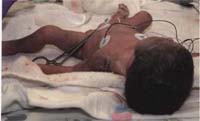7.1.2 Newborn asphyxia
As you learned in Study Session 4 of this Module, asphyxia (shortage of oxygen) in the uterus is due to an inadequate supply of oxygen from the mother’s blood or a problem in the placenta. This may result in:
- Asphyxia at birth (mild, moderate or severe)
- Learning difficulties or cognitive impairment, which become apparent during childhood development; they are due to brain cells being destroyed by lack of oxygen during labour and delivery.
- Death of the newborn.
Gas exchange is when oxygen from the inhaled air is absorbed into the blood as it passes through the lungs, and waste carbon dioxide is released from the blood into the air that is breathed out
However, neonatal asphyxia is mainly due to failure of the newborn to breathe after birth, or its heart fails to pump enough blood to the lungs for gas exchange, or it has low haemoglobin levels (anaemia) so it cannot deliver enough oxygen around the body. The baby who cannot breathe cannot establish independent life outside the mother. Therefore, the purpose of neonatal resuscitation is to help the newborn to establish spontaneous breathing and facilitate oxygen delivery to its organs and tissues – particularly the brain, which is very quickly damaged by oxygen shortage. You may also need to resuscitate any baby that is severely anaemic due to blood loss during labour and delivery, or that continues to be cyanotic despite established breathing. Cyanosis is a bluish discolouration of the lips and skin, which occurs when there is insufficient oxygen in the blood (Figure 7.2).

To avoid the immediate and long-term complications of asphyxia, in addition to the labour and delivery care that you provide to the mother, and the routine newborn care of the baby (e.g. cutting the cord, keeping the baby warm), you also have to provide life-saving interventions for any newborn who cannot breathe properly.
7.1.1 Breathing in a healthy newborn
